Twitter is unique in the social media world. Its real-time feed is what makes Twitter ideal for having conversations with an audience of millions as there are constant discussions about culture, politics, entertainment, and social issues.
For brands, it’s a place to have meaningful conversations and promote campaigns. For marketers, it provides a highly engaged audience with the potential for trending through its popular Twitter hashtag function.
But the problem is, many marketers aren’t quite sure where Twitter sits in their social media channel mix. Its real-time nature is its strength but also its weakness and many brands struggle to use it successfully as a paid channel.
In this blog, we’ll look at how marketers can use Twitter effectively for their business campaigns - organic and paid. Plus, we’ll give you some inspiration by looking at some of the best Twitter campaigns out there.
How Popular is Twitter?
Twitter is a popular social media platform with 206 million daily active users worldwide. The countries that use the network most are the United States, Japan, and India.
2021 was a particularly successful year for the channel as revenues grew 74 percent to $1.19 billion. Users also grew 11 percent in just 12 months. In 2022, Wall Street analysts estimate Twitter’s revenue will increase by 20%.
What’s the reason for Twitter’s growth? It’s seen as an authentic network to share opinions and its real-time nature enables breaking news. In fact, Pew Research found that a third of U.S. adults say the platform has helped them be more politically engaged while nearly half understand world events better.
Twitter has also made design changes such as color and typography updates and a ‘higher color contrast of buttons, links, focus’ that make Twitter content easier to use and read.
Check out the key terms unique to Twitter to get a better understanding of the network.
Who Owns Twitter?
Twitter was set up in 2006 by Jack Dorsey when he worked as part of a team at podcasting company Odeo. Dorsey went on to become CEO of Twitter twice from 2006 to 2008 and again from 2015 to 2021.
In 2013 the company went public and was valued at $31 billion. Since then it has grown to become one of the world’s most visited sites.
A shock announcement in April 2022 revealed that Tesla and SpaceX CEO, Elon Musk reached a $44 billion buyout deal for Twitter. His aim for the network is to unlock its potential as a platform for ‘free speech’. He also wants to enhance features, reduce spam and increase transparency.
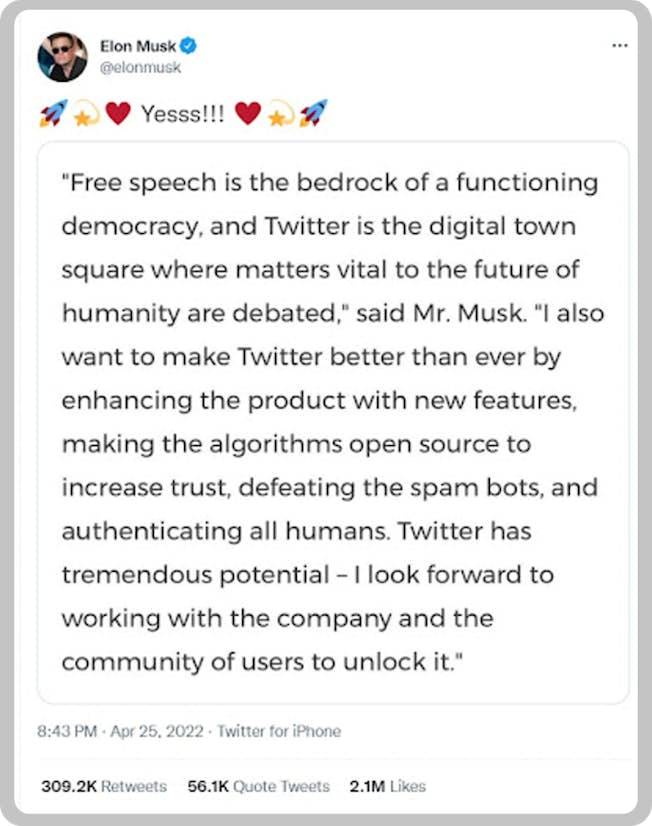
The buyout announcement has caused global controversy with many users immediately responding by pledging to shut down their Twitter accounts. Their concerns? As a self-confessed ‘free speech absolutist’, many Twitter fans worry this will result in a rise in disinformation, abuse, and hate speech.
Only time will tell how this buyout will transform Twitter…
What is Twitter Famous for?
Apart from the recent Musk buyout announcement, Twitter is famous for being about news, news, and more news!
Twitter is loved by users for its access to breaking news. It’s also a platform that enables real-time conversations and gives access to well-known personalities, influencers, and political figures.
For example, former U.S President Barack Obama has the largest Twitter account with 131 million followers.
Hashtags are an integral part of Twitter. They allow users to find relevant content quickly and Twitter features ‘trending’ hashtags in real-time. Hashtags can also be used to spark conversations and enable brands to highlight societal issues such as #BlackLivesMatter and #MeToo. Hashtags were also successful for smaller campaigns such as #BringBackOurGirls which was the campaign for the return of 276 schoolgirls that were abducted in Nigeria, and #Flygskam (‘flight shame’ in Swedish) which encourages people to avoid flying for environmental reasons.

Who Uses Twitter?
Twitter is most popular amongst the 25-34-year-old age bracket at 38 percent, followed by 35-49-year-olds at 20 percent according to Statista. In terms of gender, more men use the network at 62 percent compared to 38 percent of women.
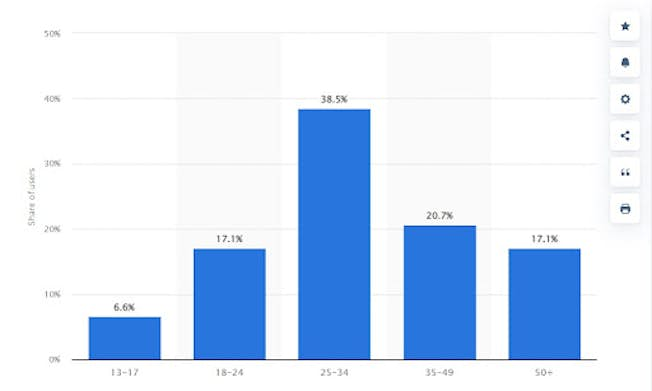
Interestingly, Twitter users are educated to a high level (42 percent to Bachelor's degree) and have high incomes, earning 9 percent more than the average American.
It also counts a list of celebrities and influencers as its fans. Justin Bieber, Lady Gaga, Cristiano Ronaldo, and the current Prime Minister of India Narendra Modi are in its top ten accounts. Plus it’s hard to forget Donald Trump’s presence on Twitter until he was suspended in 2021 for incitement of violence.
What is Twitter Used For?
There are a variety of uses for Twitter for marketers, journalists, PR experts, brands, and individuals.
Marketers can use it to start conversations and engage users along with using it to deal with complaints or queries in real-time - in effect using it as a social customer channel. They can also use it to give personality to their brand as it’s a platform that’s great for humor and provides the opportunity to reshare user posts to expand reach and boost engagement.
The media industry uses it effectively to report news at breakneck speed (although sometimes Twitter users are faster than traditional news outlets). Like in the case of the US Airways crash in 2009. Janis Krums posted a photo of the incident on the Hudson river before any media were aware of it and scooped them unknowingly.

Twitter can be used effectively by branding and PR teams to post announcements or launch products. As a platform, it’s very effective for networking and makes competitors and potential collaborators easy to find. As social branding becomes more important, Twitter offers a way to build brand awareness and avoid a social media crisis.
The beauty of Twitter for individuals is that they can curate their feed to their interests using their unique algorithm. For example, if you follow a lot of writers or publishers, the chances are the majority of posts in your Twitter feed will focus on that area. It means that individuals get the content they want.
So Twitter is great for many sectors to encourage engagement. Typically, the content that does well on Twitter includes:
- Polls or questions - Twitter polls are very popular and can be great for brands to get a feel for their audience or to just post a question and see the feedback.
- Industry news - It’s a great place to share news about your industry or open up a discussion about a new trend or development - just think how many digital marketing trends announcements tweets exist!
- Company announcements - Whether it’s a new product or a new senior hire in the company, pinning a tweet means that everyone will see it if they visit your page.
- Gifs and memes - These are staples on Twitter and tend to get great engagement. Twitter has a bank of gifs ready to use which you can search by keyword while memes can get your content noticed in the feed.
- Images - Users tweet images 361% more than video content so make sure that eye-catching images are in your content mix.
- Blogs - Blog content does well on Twitter but make sure you use an eye-catching image and short description to get clicks. Check out some useful blog tools and templates if you’re looking to ramp up your blog production.
- Events - You can promote your event in advance to drum up interest but by creating a hashtag you can also encourage participants to live-tweet at the event to drive engagement.
- Competitions or offers - Due to Twitter’s immediacy, flash sales and limited editions can do well, and competitions can draw in new followers.
How Does Twitter Work?
As a social media network, Twitter is very easy to use. To get started, you just need to create a free account and pick a name or handle.
With so many users on the network, it may take some creativity to find a name that fits. If your ideal handle is taken, think about a keyword, a short version of your company name, or include an underscore. Whatever you choose, make it easy and memorable.
After that, you’re ready to start tweeting. Twitter offers a few options for creating a tweet, from text to a gif, photo, or poll. You can also schedule a tweet and tag locations.
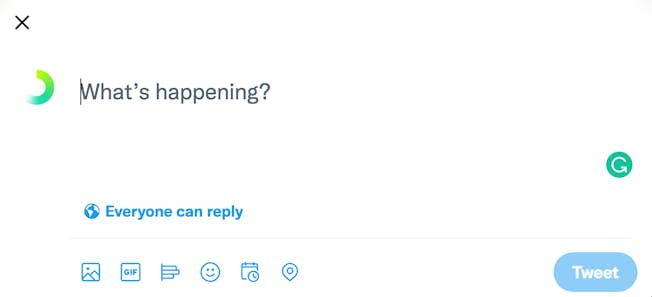
Twitter is also easy to navigate. You can go into ‘Explore’ to see trending topics or news in subject areas such as entertainment or sports.
Have a look at our blog if you’re interested in finding out how to act and react on Twitter.
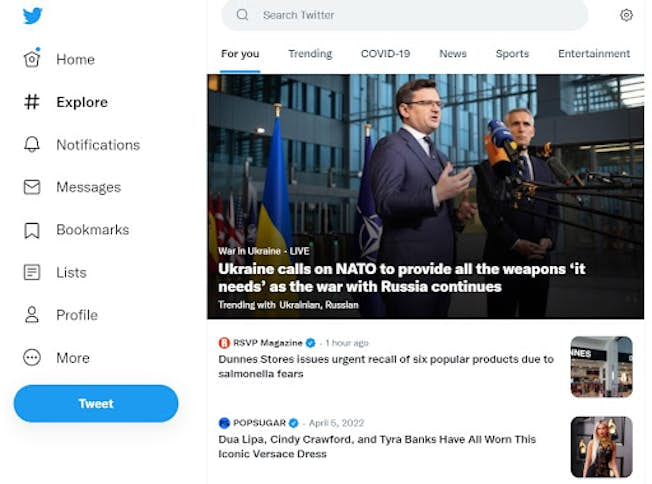
You can find people on Twitter by putting a name or brand into the search box. There are also search filters under people and location on the right-hand side. All you need to do is click on the ‘Follow’ button to start getting their tweets.
To drive engagement, you can retweet someone’s tweet, reply, like, or share. If you’re a brand looking to drive engagement amongst your user base, retweets are a great way to share other people’s content and create a discussion or get feedback from that particular user and their followers.
A new feature is Twitter Spaces which may be trying to compete with audio app Clubhouse. This function is for audio content and allows you to host, listen or speak inside a Space in an area of interest and you can also enable captions.
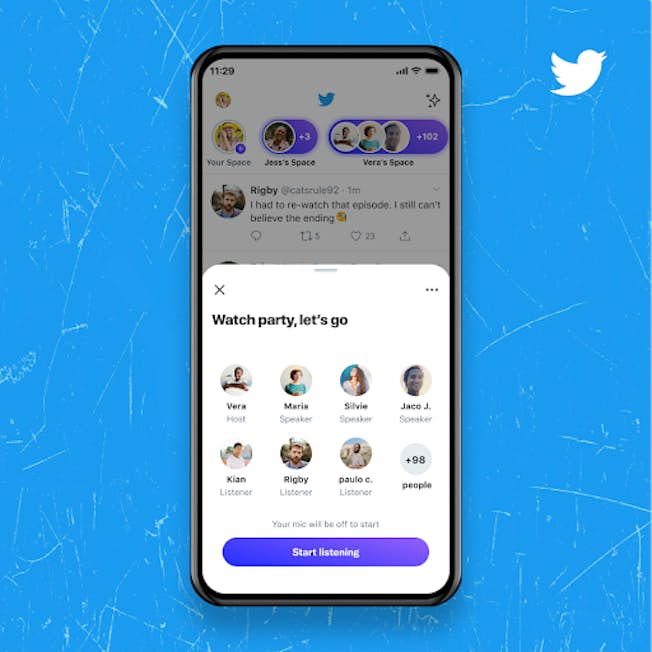
The key to Twitter is to mix up your content formats and reach out to talk to your audience. As a platform, Twitter requires two-way communication to be really effective.
How Can Marketers Use Twitter for Business?
Twitter can be useful for brands to drive brand awareness and engagement. Like any social media network, you need to understand your buyer personas and create interesting and relevant content.
Organic marketing on Twitter
From an organic perspective, there’s lots of scope for marketing on Twitter. A good place to start is to create lists that will help you segment the content you see in your Twitter feed.
For example, create a list of industry leaders or competitors or a specific product or service your company is interested in. You can also subscribe to lists for other accounts so just subscribe to their lists on their profile page.
Keywords and hashtags are useful in categorizing your content so users can find them easily. Take time to find the right hashtags and make sure you choose ones that are relevant to your industry or niche.
Polls are great for engagement and finding out more about your audience. Integrate polls into your Twitter content strategy to drive interaction and show you care about your follower’s opinions. Make sure to also share users' posts that mention your brand or hashtag and media mentions.
You can also create branded hashtags that users can use when they tweet about your company or create unique ones for a product launch or event. Don't get carried away with hashtags in your posts, one or two is enough. There are some great hashtag research tools out there to help you.
Paid marketing on Twitter
If you’re interested in going down the paid route, Twitter can be used to drive engagement for campaigns (check out our Twitter ads walkthrough if you need help getting your head around it).
You can target effectively on the ad platform and the dashboard allows you to track metrics such as impressions, engagement rates, cost-per-result, and results which are actions you assign such as web traffic. It’s also an effective network for sales teams and digital selling as many companies have acquired a customer through Twitter.
We have a handy guide on how to use Twitter analytics if you want more detail.
The ad formats you can use on Twitter are:
- Promoted ads - these can be images, videos, carousels, moments or text ads (these look the same as a normal tweet but with ‘Promoted’ at the bottom)
- Follower ads - this format helps increase visibility and can be used to promote an account to a targeted user base
- Twitter amplify - you can align your content with premium videos from relevant publishers in two ways: pre-roll or sponsorship
- Twitter takeover - this option allows your brand to take over timelines or trends which prioritizes your content
- Twitter Live - this is livestream video content that allows you to promote your brand
In terms of budget, there’s no minimum spend on Twitter so it’s really up to you what you want to invest. You can set a daily or total budget for your ads and bidding is also available which can be set as automatic if you want Twitter to do the work for you.
Consider using a paid media campaign tracker so you keep on top of what you’re spending.
How to Develop a Twitter Marketing Strategy
Devising a Twitter strategy is no different than for any other social media network. You need to think about your audience, your personality and your content.
Hashtags are an important way to not only engage but also get your content found. So think about your hashtags and research trends to see if you can newsjack effectively on the back of a current event or trending story.
You need to make engagement and community building an integral part of your strategy. That’s what Twitter is. A place for people to have conversations, start discussions or reach out for customer service.
Be conscious of the best times and days to post on Twitter or try scheduling different times to find the one that’s optimum for your brand.
From the outset, set realistic goals for your Twitter marketing activities and campaigns. It can take some time to gain followers and traction, so set goals that are achievable. If you overachieve, that’s even better!
There are a lot of options when it comes to marketing on Twitter, so experiment to see what works for you.
What Brands Use Twitter Successfully?
Brands big and small use Twitter for promotion and engagement. It’s a popular way for companies to interact with their customer base and provide an accessible channel to reach out.
Here are a few great examples of brands using Twitter successfully.
1. McDonald’s
McDonald’s is the master of advertising and its Twitter feed is full of personality. Its humorous tweets and eye-catching imagery draw people in and with 4.5 million followers, it’s obviously working.
It capitalizes on the immediacy of Twitter by launching limited edition products. Their recent schezuan sauce launch is a great example and not only features in their feed regularly in reference to a ‘sauce drop’ but is also a pinned tweet and their profile image.
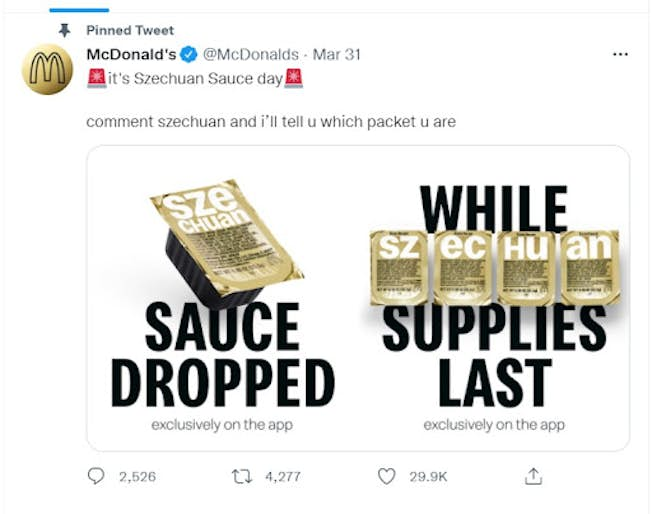
Key takeaway: Just because you’re a big brand doesn’t mean you can’t have fun on Twitter. Establish a personality and keep it consistent in posts and use Twitter to your advantage when it comes to events or launches.
2. Disney Plus
With so much content it’s no surprise that Disney Plus has a powerful presence on Twitter. In 2021, they were the most tweeted about brand due to a raft of new shows and old classic movies.
With 3.5 million followers, Disney has a legion of fans and uses Twitter to give sneak previews of movies, interviews with actors, images of its back catalog, and entertainment news such as pictures of the red carpet at the Grammys. It seems that Twitter users can’t get enough of the magic of Disney.
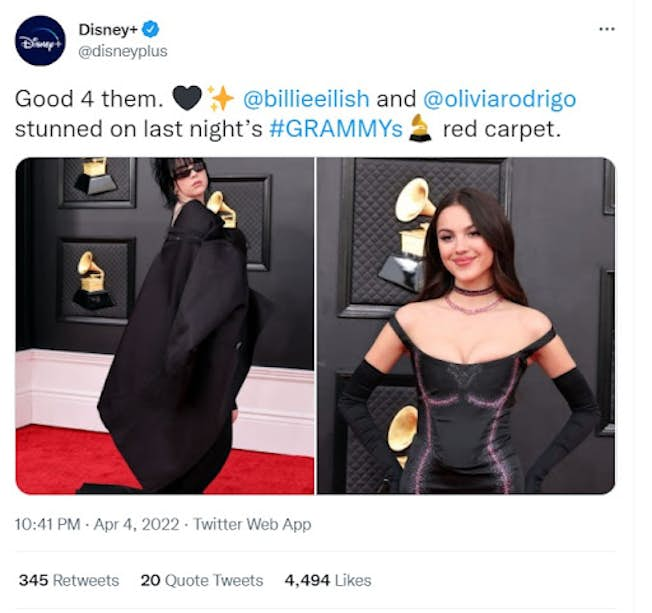
Key takeaway: Focus on your product or service but also post content that links to your industry and is timely. This will expand your reach and help you get under the eyes of users that may never have come across your brand.
3. Charmin
You wouldn’t think there was much to say about toilet paper, but Charmin manages to give a boring product a real personality. Their feed is full of puns like ‘no butts about it’, ‘take the throne’, and ‘a big stink’.
The brand recently piqued followers' interest by announcing a big reveal on the date 2.22.22. It turned out to be a giant floating poop in New York harbor that saw people post images and videos across Twitter with the hashtag #Charmin2sday that the brand then shared.
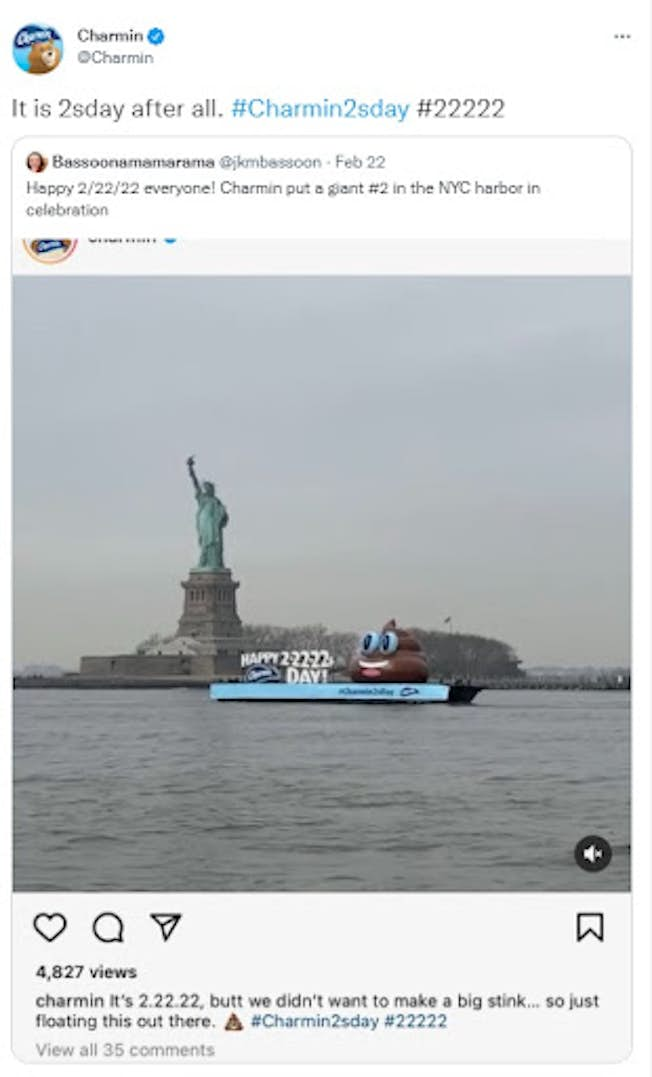
With nearly 85,000 followers Charmin do a good job of engaging Twitter users about one (not really talked about) product.
Key takeaway: Don’t limit yourself on Twitter just because you only have one product or service. Be creative with your feed and look to link your product to something original or quirky to help it stand out.
4. PlayStation
As one of the most popular company accounts on Twitter, the gaming brand PlayStation has nearly 25 million followers. It uses Twitter to promote games and launches through gameplay footage and trailers but also uses it as a customer service channel.
Being proactive is what makes PlayStation so successful on Twitter as it responds to customer queries and comments along with providing game recommendations. It also hosts monthly Players' Choice polls to engage its community.
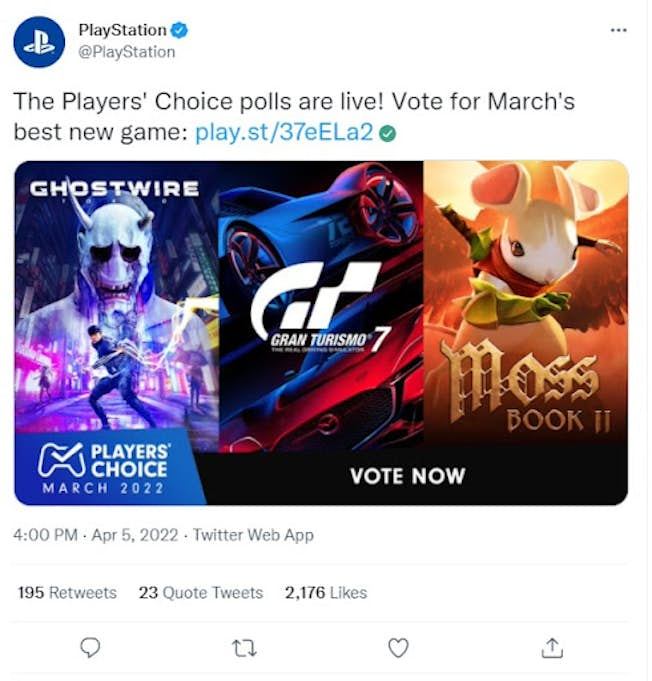
Key takeaway: Interaction is key on Twitter, people want to be engaged and asked their opinions as brand followers. So give them opportunities through polls to interact and post questions to get some insight on a product or service.
5. Innocent Drinks
A small brand on Twitter compared to the others on this list, Innocent drinks still packs a punch with its witty posts. While the brand does promote products in its feed, it mainly posts conversational tweets about the weather and quirky content like the innocent dog translator.
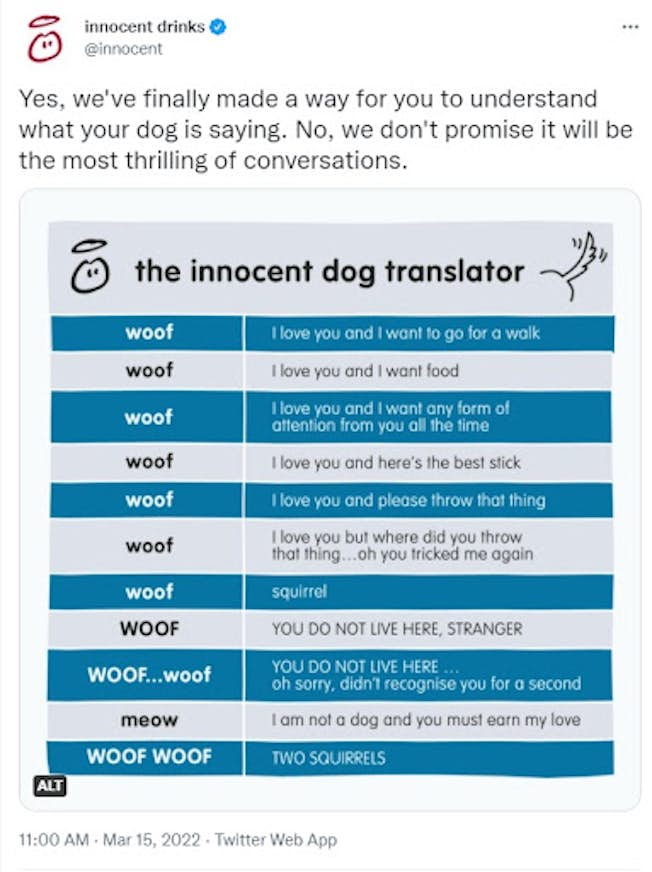
It sets the tone and personality of the brand at the start with its Twitter bio reading as ‘We make healthy drinks. Please buy one so we don't get fired.’
Key takeaway: Twitter is not all about promotion. You can have fun with it and engage followers with topics that you may chat to someone about in the street such as the state of the weather in the UK or how to talk to dogs!
6. NASA
With 55 million followers, NASA has a huge following on Twitter. Its feed is full of space-related images and videos of interviews or panel discussions. It also gives behind-the-scenes footage of astronauts and employee stories.
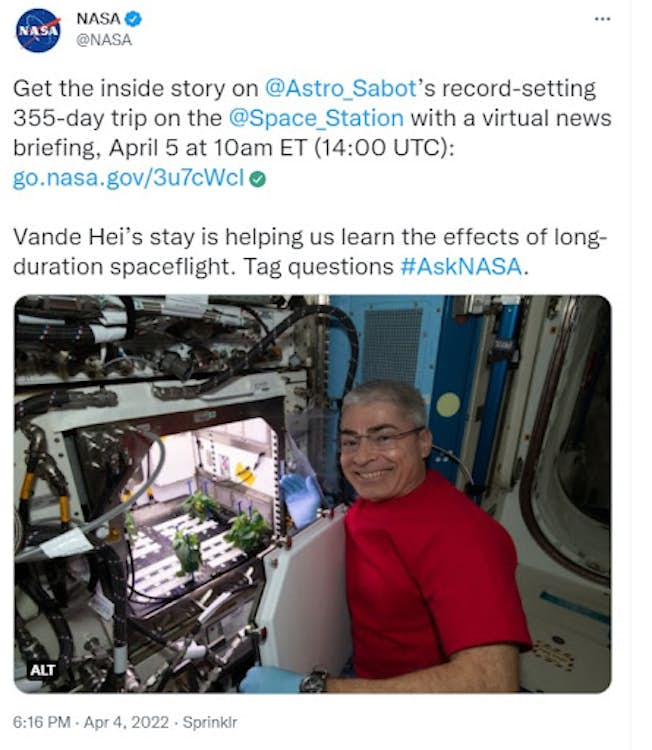
Even though it’s a brand that may be deemed as ‘techy’, NASA doesn't take itself too seriously with a bio that reads ‘There’s space for everybody’ and location as ‘’Pale Blue Dot’.
Key takeaway: If your brand is in an industry that has a serious edge to it, don’t let that limit your social media activity. Capitalize on any imagery or video content you may have to let people take a peek behind the curtain to show how things work.
What’s Next for Twitter?
Twitter has lofty goals for the future. In 2023 it has set targets to double revenue to $7.5 billion and grow to 315 daily users. So how is it going to achieve that?
The network is focusing on attracting and retaining creators in 2022 and beyond by offering a range of new features along with launching a subscription service for premium users called Twitter Blue.
The first new feature is ‘super follows’ which enables users to charge monthly subscriptions for valuable content. This will help creators earn revenue from their Twitter content and could be fruitful for brands that create original content or research.
It will also be interesting to track how the new Twitter Spaces audio feature performs as users can connect with users and brands with similar interests.
Twitter has also invested in the newsletter platform Revue which will be integrated into the platform. Other acquisitions include Sphere, a UK-based chat app to expand its community feature, and Threader, an app that makes threads more readable.
With all of these opportunities on the social network, Twitter may just realize its goals for 2023.
Become a Twitter Master
Now that you know how successful Twitter can be, it’s time to ensure you have the knowledge and skills needed to master it. DMI’s Social Media Marketing course will cover each platform including Twitter and teach you about social customer service, social strategy, social content, social commerce, and affiliate marketing.
Related
Upgrade to Power Membership to continue
your access to thousands of articles, toolkits, podcasts, lessons and much much more.
Become a Power Member- Login
- View Courses
- - - -
- Courses
- Resources
- - - -
- My Account
- Change Password
- Logout





